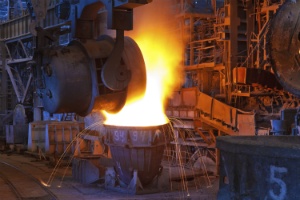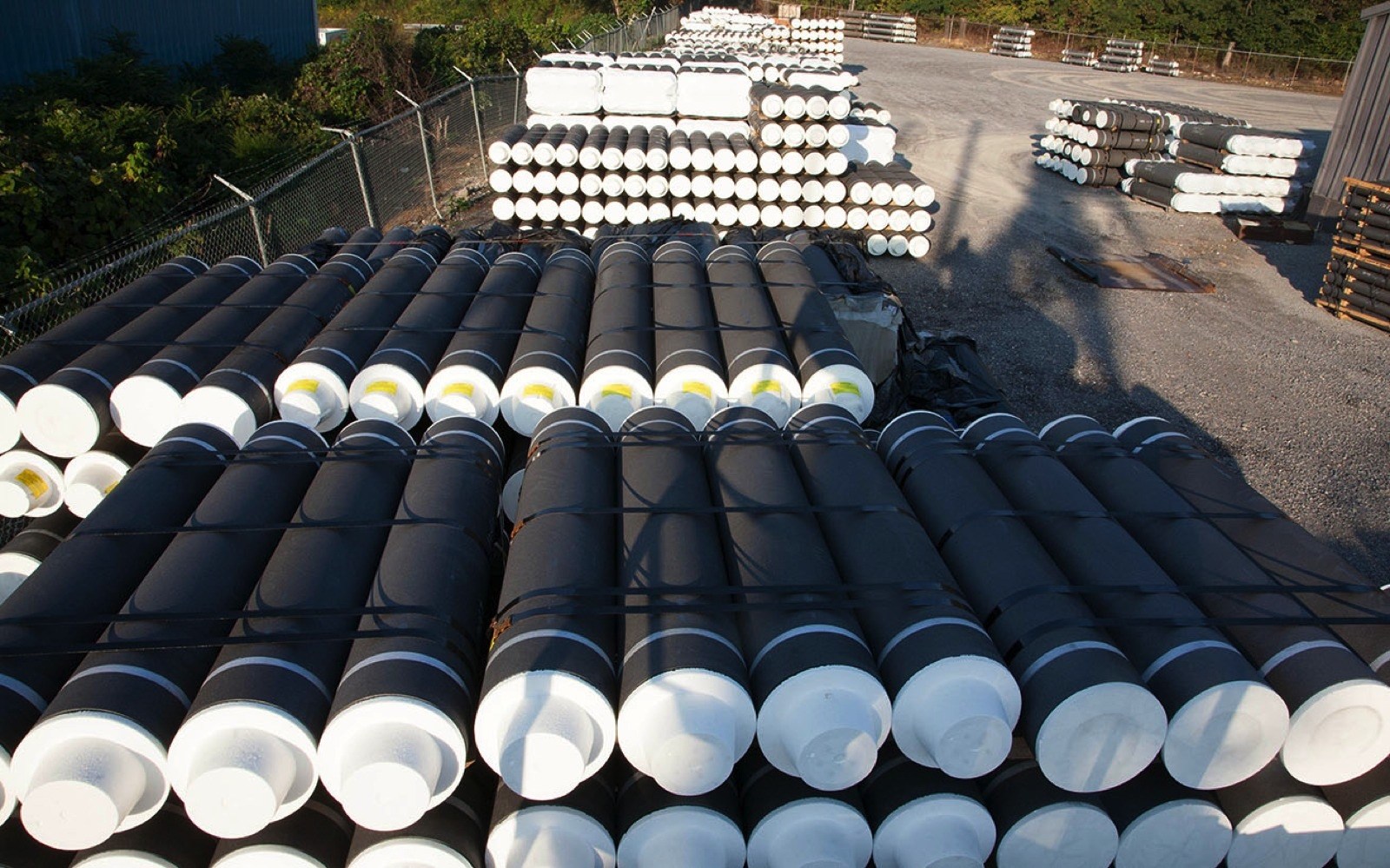Graphite electrodes carry the electric current to create an arc that generates the heat required to melt and/or process various materials in electric arc furnaces (EAF). GES-AGM offers several grades and sizes of electrodes to match the customers most demanding requirements for their particular process.
GES-AGM Graphite offers 3 TPI, 4 TPI, and Male/Female connections. GES-AGM Graphite delivers graphite nipples with each electrode based upon customer requirements. All nipples are manufactured with 100% needle coke and the quality is certified by our technical team. Additional nipples are available upon request. GES-AGM Graphite guarantees all nipples meet industry specifications and will meet the customers expectations.
| Diameter | Premium | XP | UHP | |
| mm | 50 – 450 | 50 – 550 | 200 – 700 | |
| inch | 2 – 18 | 2 – 22 | 8 – 28 | |
| Density | g/cc | 1.62 – 1.65 | 1.64 – 1.68 | 1.67 – 1.73 |
| Resistivity | u Ω m | 6.5 – 7.0 | 5.5 – 6.0 | 4.5 – 5.0 |
| Ash | % | 0.2 – 0.4 | 0.2 – 0.4 | 0.2 – 0.4 |
| Bending Strength | MPa | 8.0 – 10.0 | 9.0 – 12.0 | 10.0 – 13.0 |
| C.T.E. (100-600°C) |
x10-6 | 2.5 – 2.9 | 2.0 – 2.4 | 1.5 – 1.9 |
| Nominal Diameter | Full Tolerance | Nominal Length | |||
| min | max | ||||
| mm | inch | mm | mm | mm | inch |
| 75 | 3 | 73 | 78 | 1000 / 1200 / 1500 / 1800 | 36 / 48 / 60 / 72 |
| 100 | 4 | 98 | 103 | 1200 / 1500 / 1800 | 48 / 60 / 72 |
| 125 | 5 | 127 | 132 | 1200 / 1500 / 1800 | 48 / 60 / 72 |
| 150 | 6 | 148 | 154 | 1200 / 1500 / 1800 | 48 / 60 / 72 |
| 200 | 8 | 200 | 205 | 1500 / 1800 | 60 / 72 |
| 225 | 9 | 225 | 230 | 1500 / 1800 | 60 / 72 |
| 250 | 10 | 251 | 256 | 1500 / 1800 | 60 / 72 |
| 300 | 12 | 302 | 307 | 1500 / 1800 / 2100 | 60 / 72 / 84 |
| 350 | 14 | 352 | 357 | 1500 / 1800 / 2100 | 60 / 72 / 84 |
| 400 | 16 | 403 | 409 | 1500 / 1800/ 2100 / 2400 | 60 / 72 / 84 / 96 |
| 450 | 18 | 454 | 460 | 1500 / 1800 / 2100 / 2400 | 60 / 72 / 84 / 96 |
| 500 | 20 | 505 | 511 | 1800 / 2100 / 2400 / 2700 | 72 / 84 / 96 / 110 |
| 550 | 22 | 556 | 562 | 1800 / 2100 / 2400 / 2700 | 72 / 84 / 96 / 110 |
| 600 | 24 | 607 | 613 | 2100 / 2400 / 2700 | 84 / 96 / 110 |
| 650 | 26 | 657 | 663 | 2400 / 2700 | 96 / 110 |
| 700 | 28 | 708 | 714 | 2400 / 2700 | 96 / 110 |
| Nominal Length | Full Tolerance | ||
| min | max | ||
| mm | inch | mm | mm |
| 1000 | 36 | 900 | 1110 |
| 1200 | 48 | 1100 | 1250 |
| 1500 | 60 | 1400 | 1600 |
| 1800 | 72 | 1700 | 1905 |
| 2100 | 84 | 1975 | 2210 |
| 2400 | 96 | 2275 | 2515 |
| 2700 | 110 | 2550 | 2895 |
| Nominal Electrode |
Nipple Size |
|||
| mm | inch | mm | Length/mm | Type |
| 350 | 14 | 215.1 | 304.8 | 215T3 |
| 400 | 16 | 215.1 | 304.8 | 215T3 |
| 400 | 16 | 241.3 | 338.6 | 241T3 |
| 450 | 18 | 241.3 | 388.6 | 241T3 |
| 450 | 18 | 273.1 | 338.6 | 273T3 |
| 500 | 20 | 273.1 | 355.6 | 273T3 |
| 550 | 22 | 298.5 | 372.5 | 298T3 |
| Nominal Electrode |
Nipple Size |
|||
| mm | inch | mm | Length/mm | Type |
| 75 | 3 | 41.2 | 103.0 | 41T4N |
| 100 | 4 | 66.7 | 135.0 | 66T4N |
| 125 | 5 | 69.8 | 153.0 | 69T4N |
| 150 | 6 | 88.9 | 169.0 | 88T4N |
| 200 | 8 | 122.2 | 177.8 | 122T4N |
| 225 | 9 | 139.7 | 177.8 | 139T4N |
| 250 | 10 | 152.4 | 190.5 | 152T4N |
| 300 | 12 | 177.8 | 216.0 | 177T4N |
| 350 | 14 | 203.2 | 254.0 | 203T4N |
| 400 | 16 | 222.3 | 304.8 | 222T4N |
| 450 | 18 | 241.3 | 304.8 | 241T4N |
| 500 | 20 | 269.9 | 355.6 | 269T4N |
| 550 | 22 | 298.5 | 355.6 | 298T4N |
| 600 | 24 | 317.5 | 355.6 | 317T4N |
| 650 | 26 | 355.6 | 457.2 | 355T4N |
| 700 | 28 | 374.7 | 558.8 | 374T4N |
| Nominal Electrode |
Nipple Size |
|||
| mm | inch | mm | Length/mm | Type |
| 400 | 16 | 222.3 | 355.6 | 222T4L |
| 450 | 18 | 241.3 | 355.6 | 241T4L |
| 500 | 20 | 269.9 | 457.2 | 269T4L |
| 550 | 22 | 298.5 | 457.2 | 298T4L |
| 600 | 24 | 317.5 | 457.2 | 317T4L |
| 650 | 26 | 355.6 | 558.8 | 355T4L |
| 700 | 28 | 374.7 | 558.8 | 374T4L |
Brochures
Technical Support

GES-AGM has a group of experts in the field of servicing graphite electrodes. All of our technicians are trained engineers that have worked in furnaces or within graphite manufacturers in the past. We know all of the EAF, Ladle, and Foundry applications throughout the Americas.
Beyond the standard procedure of selling electrodes, we help the customer in many ways. This includes identifying a problem before it happens, increasing productivity, training employees on the job, and solving any problems the customer may have at that time.
We offer many services including monitoring a trial, performance analysis, storage in our warehouses, inspection of accessories, and monitoring the furnace. GES-AGM Graphite offers these services in part of selling the raw materials.
Electrode Handling
Graphite electrodes are heavy and slippery. While handling, caution should be exercised at all times. The following points are offered as suggestions.
- When unloading pallets upon receipt, unloading individual electrodes, or transporting to the EAF, care should be taken to insure lifting is secure.
- When the individual electrode is being lifted by crane or by forklift, personnel should allow safe distance staying well clear of the load. Use roll blocks/stoppers to prevent uncontrolled rolling of the electrode.
- During storage, minimize stack height to avoid an unstable condition. Consult with engineering or warehouse management for the maximum height for safe storage.
- During usage the electrode, and/or electrode column, may drop or swing causing potential physical injury to shop personnel or damage to equipment. Therefore, GES-AGM recommends the following:
- Do not use any electrodes whose threads or end faces are damaged or broken. Contact supervision.
- When connecting, first clean the joint by air-blowing insuring a clean face and threads. To prevent the joint from becoming dirty, use a column cap.
- When moving an electrode to move to or from the EAF, avoid lifting in the socket area by securing the electrode body inside of the designated socket limit stripe marked on the electrode body.
- Securely center and tighten the electrode with the proper wrench and specified torque. Do not use any electrode column with a loose joint.
- Be aware that since graphite conducts electricity and heat well, the electrode may give an electric shock or cause a burn.
- During operation, maintain a safe distance from the furnace observing all shop safety rules. If required to enter the EAF area, always wear protective heat resistant clothing, gloves/face and eye protection, etc
- On handling broken or used electrodes, follow these precautions:
- When removing an electrode from the EAF, use a chain or tongs to secure the electrode. Do not use a wire lift as that could allow the electrode to slip free.
- During the lifting of an electrode, remain well clear of the suspended electrode and the travel pathway.
- When cutting a broken electrode, use a dustproof mask/goggles and a dust collector to avoid the fine dust that occurs which can be harmful to lungs and eyes by inhalation and adhesion.
- At the sign of any physical disorder, contact first aid and/or a doctor.
- Be careful to avoid slippage in areas exhibiting graphite dust. Do not step on any bare slippery electrodes.
- Even when appearing black, an electrode may be too hot to touch. Do not leave any combustible material in a broken electrode yard.

